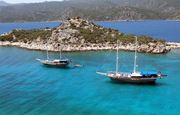      
Tourism in Turkey is focused largely on a variety of historical
sites, and on seaside resorts along its Aegean and Mediterranean
Sea coasts. In the recent years, Turkey has also become a popular
destination for culture, spa, and health care tourism. In 2010,
Turkey attracted more than 28.6 million foreign tourists.
Istanbul is one of the most important tourism spots not only in
Turkey but also in the world. There are thousands of hotels and
other tourist-oriented industries in the city, catering to both
vacationers and visiting professionals. Turkey's largest city,
Istanbul, has a number of major attractions derived from its
historical status as capital of the Byzantine and Ottoman Empires.
These include the Sultan Ahmed Mosque (the "Blue Mosque"), the
Hagia Sophia, the Topkapı Palace, the Basilica Cistern, the
Dolmabahçe Palace, the Galata Tower, the Grand Bazaar, the Spice
Bazaar, and the Pera Palace Hotel. Istanbul has also recently
became one of the biggest shopping centers of the European region
by hosting malls and shopping centers, such as Metrocity, Akmerkez
and Cevahir Mall, which is the biggest mall in Europe and seventh
largest shopping center in the world. Other attractions include
sporting events, museums, and cultural events.
Beach vacations and Blue Cruises, particularly for Turkish
delights and visitors from Western Europe, are also central to the
Turkish tourism industry. Most beach resorts are located along the
southwestern and southern coast, called the Turkish Riviera,
especially along the Mediterranean coast near Antalya. Antalya is
also accepted as the tourism capital of Turkey.[2] Major resort
towns include Bodrum, Fethiye, Marmaris, Kuşadası, Çeşme, Didim and
Alanya.
Lots of cultural attractions elsewhere in the country include
the sites of Ephesus, Troy, Pergamon, House of the Virgin Mary,
Pamukkale, Hierapolis, Trabzon] (where one of the oldest
monasteries is the Sümela Monastery), Konya (where the poet Rumi
had spent most of his life), Didyma, Church of Antioch, religious
places in Mardin (such as Deyrülzafarân Monastery), and the ruined
cities and landscapes of Cappadocia.
|
